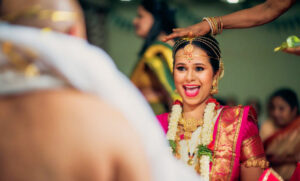Weddings are special and Indian Bengali Weddings are just a step better. Every community has its own set of rituals for every occasion. This diversity is what makes our country the best blend of tradition and culture.
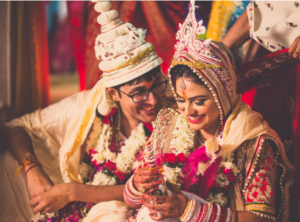
Weddings in every region and community differ, yet their rituals and traditions remain common. Bengali weddings are an elaborate blend of customs and rituals which serve as a treat to our eyes.
Though Bengali weddings are not luxurious they do demand precision in performing the rituals. Here we have done a detailed analysis of all the picturesque rituals and traditions of the Bengali weddings.
Pre-wedding Rituals of a Bengali Weddings

Picture Credit-: bengaliwedding
Bengali weddings rituals begin a few months prior to the actual wedding date. Some rituals might have become obsolete today, yet, a few are rigorously followed.
Adaan Pradaan
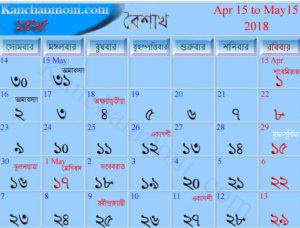
There was a time when the families of the bride and the groom would meet at a place and fix the date for the auspicious occasion. The horoscope of the bride and groom would be matched and both the families would exchange gifts.
This ritual stands outdated today, the horoscope of the bride-groom is matched online and the date is communicated over the telephone.
Aashirvaad (Similar to Engagement Ceremony)
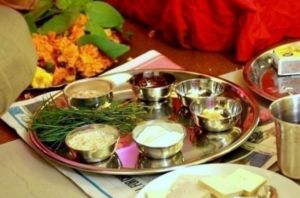
This ceremony marks the formal acceptance of the bride and groom on by either family. The elders of the family put husked rice and trefoil leaves on the head of the bride and groom and present them with gold ornaments as a sign of love and acceptance. This ceremony can be held either prior to the wedding or on the very day. This is also considered similar to the Engagement ceremony.
Aai Buro Bhaat
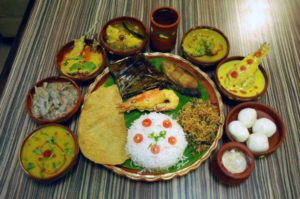
This ritual is the Bengali version of a bachelorette party. This ceremony takes place in the presence of near relatives, neighbours, and friends where the bride and groom are offered a platter of traditional Bengali delicacies, which is considered to be their last meal as a spinster or a bachelor.
Today the concepts of mehendi and sangeet have also been borrowed from North Bengali Weddings and merged with the Aai Budo Bhaat.
Dodhi Mangal
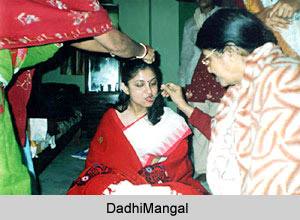
This ceremony takes place at the dawn of the wedding day. The ladies of the bride and groom’s family move together to a waterbody nearby to fill a pitcher of water, this water would be used for the snan ritual.
Post the water-filling ritual, the would-be couple is fed a preparation of curd, rice flakes, bananas and sweets at their homes and they are supposed to fast after having this meal until their bengali weddings ritual is over.
Nanhi Mukh/Vriddhi Sraddha
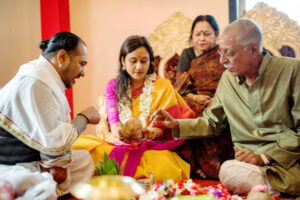
This ritual is performed just before the ‘gaye holud’ ceremony of the bride or the groom. For this occasion, a priest chants Vedic incantations and the families pay homage to their forefathers asking for their blessings.
Tattva

On the morning of the Bengali Weddings day, the groom’s family send gifts better-called tattva to the bride’s family. In the tattva there are gifts for each and every family member of the bride, a new saree for the bride which she will wear during the Gaye Holud ceremony along with it goes a big, decorated rohu fish, mustard oil, sweets and savouries, and personal grooming products for the bride.
Gaye Holud or the Haldi Ceremony
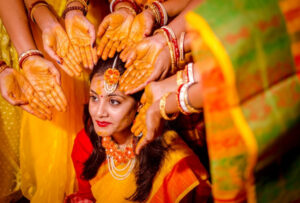
Picture Credit -: gayehalud
In this ceremony, a turmeric paste is applied on the body of the groom. This same paste is carried to the bride along with the tattva by the members of the groom’s family. The same paste is applied on the bride’s body and then the water brought from the water body is used to bathe the bride and groom respectively.
Sankha Porano
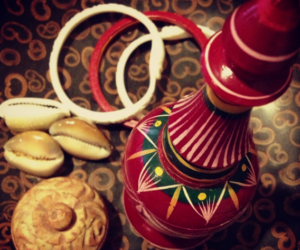
In Bengali weddings rituals, sankha and pola are considered to be auspicious and signs of a married woman. The bride is made to wear red and white conch shells- the white being the sankha and the red being the pola. The bride has to wear them before her gaye holud ceremony.
Bengali Weddings Rituals
Bor Boron
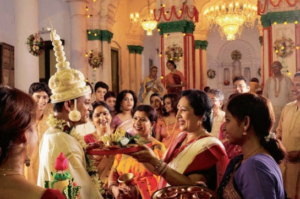
Bengali Hindu Weddings take place within a specific time period which is called the lagna. The groom with his family and friends reaches the wedding venue where at the entrance, the bride’s mother welcomes him with an aarti and tilak. The other guests of the groom’s family are also received with equal warmth and are served with light refreshments.
Potto Bostro

The groom arrives in dhoti and kurta which is the traditional attire for men in Bengal. When he is seated at the chaadnatola where the wedding rites would be performed, an elderly male member of the bride’s family would gift the groom new clothes which he would wear during thebengali weddings ritual. These clothes are known as potto bostro.
Saat Paak

The bride enters the chaadnatola where the groom is already seated with the priest. The bride is seated on a pidi or a low wooden stool, carried by her brother and other male members of the family and is carried around the groom seven times in a row. This process is called saat paak.
Subho Dristi
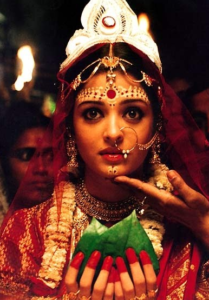
During the process of saat paak, the bride keeps her eyes covered with beetle leaves and only on the completion of the seven rounds she sets her eyes on the groom amidst the sound of conch shells and ululations. This ritual is called subho dristi.
Mala Badal

Mala badal is the ritual that follows subho dristi. The bride and groom exchange garlands made of fragrant flowers three times as a sign of their acceptance of each other.
Sampradaan
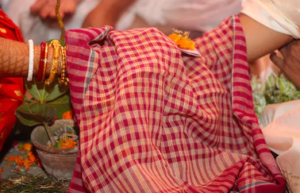
An elderly male member of the bride’s family hands the bride over to the groom and ties their hands with sacred threads. They are supposed to stay like this until the end of the rituals. This ceremony is called sampradaan or kanyadaan.
Saat Paak (on feet)
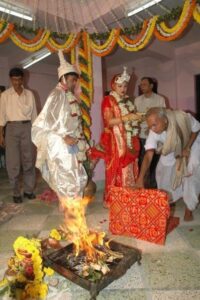
According to the Vedic rituals, the priest solemnizes the marriage in the presence of Fire God or Agnidev. The bride and groom are asked to go around the pyre or the fire seven times. The uttariya worn by the groom and the end of the bride’s saree is tied in a knot which is known as gantchhora. These seven steps that they take are known as saat paak.
Anjali / Kusumdinge

In this ritual, the bride stands in front of the groom and holding chaff in hand, by the process of winnowing, khoi is thrown into the fire. This ritual is called Kusumdinge or Anjali.
Sindoor Daan & Ghomta
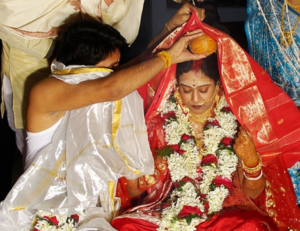
The groom puts a vermillion mark or sindoor on the forehead of the bride and covers her head with a new saree provided by the groom’s family. This ritual is known as Sindoor Daan and it marks the end of the Bengali weddings rituals with the couple being pronounced husband and wife.
Bengali Weddings rituals
Basar Ghar
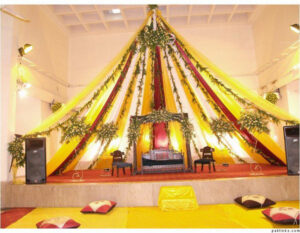
This is the ritual where the couple, as well as some young members of the family, loosen up in the presence of one another. On the night of thebengali weddings, after all the guests have departed, the couple along with some young members of the family occupy a room or basar ghar for fun and merriment. They play different games, dance, and sing, chat and have fun.
Bidaay & Bodhu Boron

It is time for the bride to leave her father’s home and move in with her in-laws. While she departs, she keeps throwing fistfuls of rice backward without turning back. This way, she tries to repay the debts of her father.
The newly-wed couple then arrives at the groom’s house where the groom’s mother now welcomes them with aarti and tilak. Also, the impression of the bride’s foot is taken on a white cloth using red colour dye. This ritual is called bodhu boron or welcoming the bride into the groom’s family.
Kalraatri
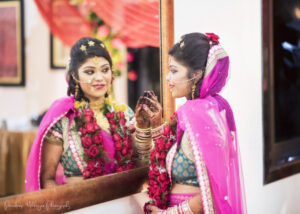
On the first night that the bride spends at her in-law’s house, the couple is supposed to sleep in separate rooms. This is known as kalraatri.
Post wedding rituals
Bou Bhaat & Reception

On the second day of the marriage, the bride cooks some dishes and serves it to her husband and other members of the family. This ceremony is called bou-bhaat. The husband also has to pledge to shoulder the responsibilities of the bride for the rest of his life by handing her a saree and a plate of food. This ceremony is known as bhaat kapor.
That day in the evening, the groom’s family arranges a grand reception to honour the couple. Guests from both the families are invited to join the dinner and bless the couple.
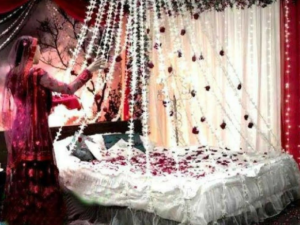
This ceremony is held on the second night of the marriage. The couple sleeps together on a bed decorated with flowers.
Oshtomongola
On the eighth day after the marriage, the couple arrives at the house of the bride. It is another time for merriment and joy on the part of the bride’s family. Guests are invited to partake of the happiness.
With this, the bengali weddings rituals of the Bengali Hindu culture comes to an end. Though Bengali marriages are laborious and time-consuming, there is no ritual as picturesque as these.



